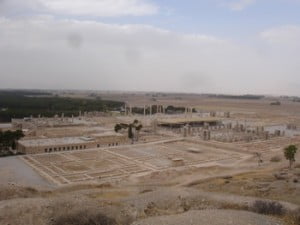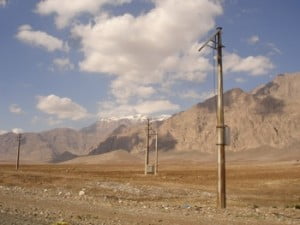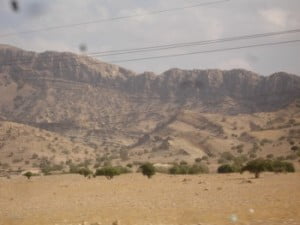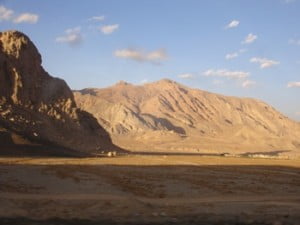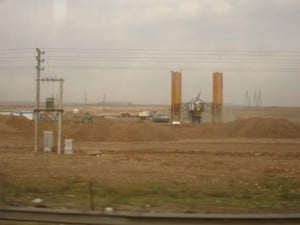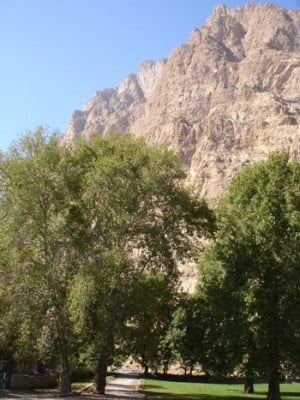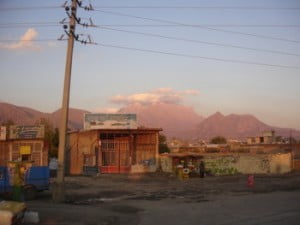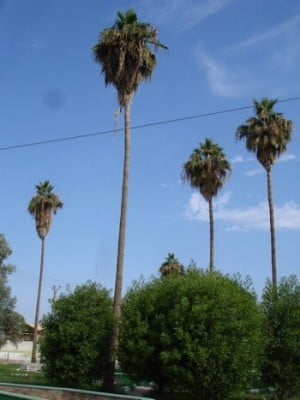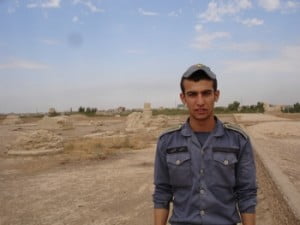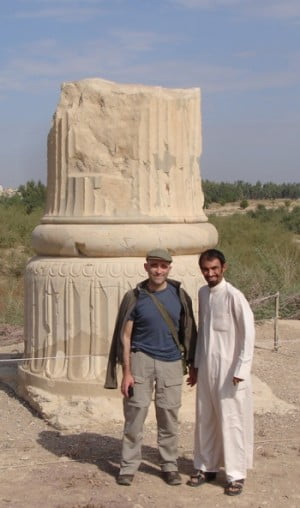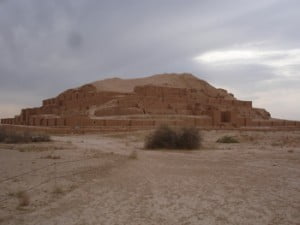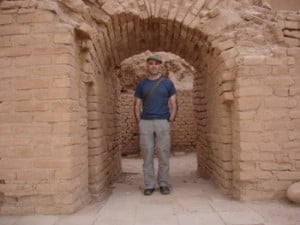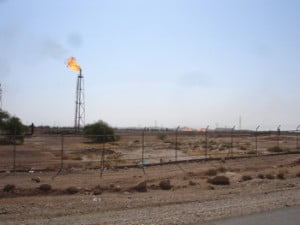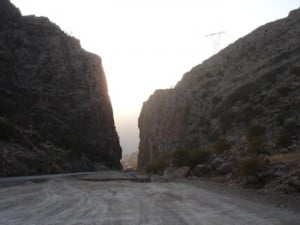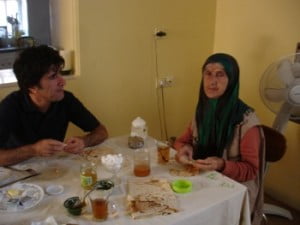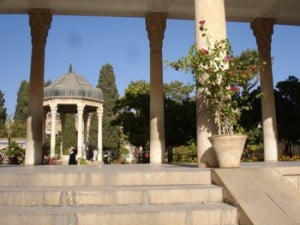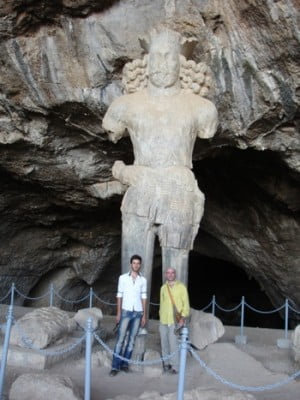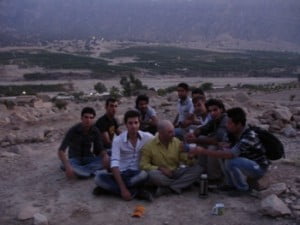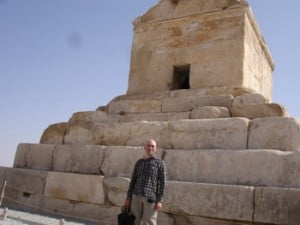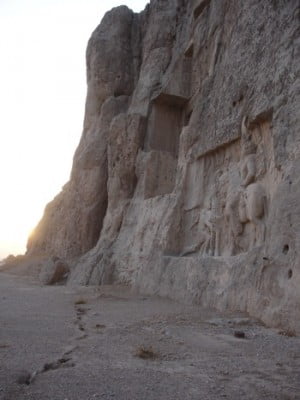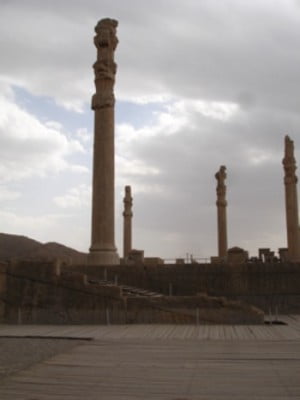perspectives…
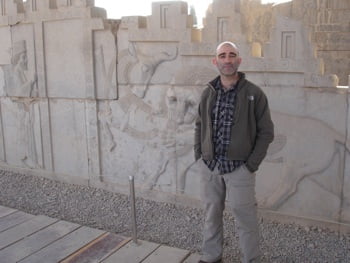
The bulk of this was written the day before yesterday, but I was unable to post it then. I have also added an extra paragraph just now, from my hotel in Yazd that happens to have wi-fi…
I have just returned from five hours at Persepolis. This ruined palace is probably the single most important reason I came to Iran. But now I have that feeling of exhaustion that I comes upon me (I’m pretty certain this is a common experience) whenever I spend a long time in a museum or gallery. No doubt it is my brain’s natural reaction against being stuffed like a haggis.
It’s probably too soon for me to be able to express anything very sensible about the experience – I have been dreaming about Persepolis since I was a child and what I have just done is to attempt to replace the complex mental ‘fantasy’ I have of the place with the visceral reality of having actually been there. To some extent this was a brutal process.
My core reason for coming to Iran was to recalibrate my conceptions of the place by access to direct experience. This is not without its perils – or perhaps, less dramatically, it is difficult. (Can I just state that, in the following, when I use “I” I really mean “we” – because I am confident that what I am describing here is a common experience – indeed, if it were not, I wouldn’t wish to be inflicting on you what would then seem to be merely ‘a tour of the mental processes of a madman’ *grin*) An effect of all this travelling is, for example, to ‘stretch space’. By this I mean that any book-derived knowledge of a place will reside within my mind in a peculiarly ‘compressed’ form. This form is not devoid of measurements nor awarenesses of scale, but this is true only in a peculiar mental sense, as if the thing is being seen through a prism. The book I am intending to write set in ancient Iran, has an almost complete ‘life’ of this kind already in my mind. I could have written the book entirely without coming to Iran, but then it could never hope to escape the prison of the prism and it would be a less ‘real’ thing than I would like it to be.
Seeking this link to ‘reality’ is necessarily a delicate business. First there is that ‘stretching of space’ malarkey that I have already mentioned. As I travel about, places, that were merely points on a map, pull apart and the true vastness of this land becomes apparent. As the landscapes stretch, there is a tendency for the characters I intend to people them with to shrink. I am reminded of how a Chinese painter, when first shown by an European the supposed aesthetic advance represented by perspective, is claimed to have said: that’s a nice trick, but is it art? Apocryphal or not, this seems to me to demonstrate the truth that we want our stories to have people firmly in the foreground and as large if not larger than life.
A second potential problem is that the Iran that ‘is’ exists raucously in the bustling modern life of its people and is constantly in my face (and very often up my nose in the guise of exhaust fumes). Though of course this constitutes the truest joy of being here, the Iran that I seek for literary purposes is the faintest impression on a page that has been constantly overwritten for more than 2000 years. A ruin, when you walk among its tumbled stones, actually works more against a reimagining of the building it was than if there were nothing there at all (assuming you have some description of it from some other source from which to imagine it into existence). I certainly find that the reality of what my senses are perceiving tends to overwhelm any imaginings I may have had – at least temporarily. Additionally, the land here has either suffered the general ecological degradation that all lands seem to suffer from long human occupation, as well, perhaps, some climate change on top (my impressions from what I’ve seen suggest that the dramatic drying of the landscape has been caused by deforestation). There is also the polution that I’ve already talked about that daily hazes out that famous ancient clear light.
So you can imagine my delight when I chartered a taxi to set off to see Darius’ inscription high on a cliff at Bisotun and found not the clutter of modern urbanity I expected to find, but a cliff rising craggily to the bluest sky and, at its foot, where anciently there had been a ‘paradise’ (a walled hunting park and garden), stood a shady gathering of trees through which streams ran glinting from a waterfall that tumbled from a pool. In truth this is all artificial, but no more so than had been Darius’ paradise, and no less delightful for that. I lingered there for hours and climbed the slope of the mountain so that I could gaze down upon the plain. Here at least it was easy to imagine Darius and his court on the migration from Babylon (not far from Bagdad), fleeing the coming of the brutal Iraqi summer, and marching along the road that led to the cool, breezy palace at Hamadan.
Later, to my great frustration, I could find no bus to take me, from Kermanshah down to Khouzistan, that didn’t travel at night. I thus made the descent from the Zagros mountains in darkness. It was after midnight when I decided to take the risk of bailing out at Andimeshk – rather than continuing on for another two hours to Ahvaz. I was the only person getting off there and, finding a taxi, I got in. There were two other guys in the car, and as they chatted to each other and the driver, and he made some strange changes of direction, I grew a tad concerned that this was some kind of setup – and so was much relieved when we stopped outside the hotel I had asked for. Paranoia, of course, and probably due to extreme tiredness. A cause for concern here is that, because of the sanctions imposed on Iran, their banks have no contact with ours. Consequently, all the money any traveller here has access to, he has to carry with him. But, as I have said – it was just paranoia – I have never actually had cause to feel in any way in danger.
The change in temperature from Kermanshah to Khouzistan was dramatic. When I woke the next morning, in my cheap and not so cheerful hotel room, I looked out and saw date palms rising from among the dusty, flat roofed houses. The fears of the previous night forgotten, I went out seeking breakfast – this was the first hotel I had come across that didn’t serve any. I found a tiny little place where the owner gave me tea and a hunk of baguette stuffed with falafels and salad. He was very welcoming and refused to take any payment. I found a minibus to take me to Shush – ancient Susa, and the second of the three Achaemenid capitals (the other being at Hamadan, where, alas, there was very little to see) I came to look at.
My experience of ancient Susa – where the remains are scanty, though enough for us to have a clear idea of the layout of the palace there, and its relationship to the ancient city – was somewhat ‘enlivened’ by a number of factors. The first was that, like a mad dog, I had decided to carry out my investigation of the ruins under the noonday sun – admittedly, I was on a schedule – but I hadn’t even had the sense to wear a long-sleeved shirt, nor to put on any sun cream – nor even to bring the umbrella that I had bought in Kermanshah (after having been royally soaked for two days on the trot, only for the clouds to part, so that I’ve not used it in anger, except to wander around another ruined city looking, no doubt, like some retired vicar out of some Merchant Ivory film). The next factor was the ever-so-keen young soldier who seemed intent on bounding around me wishing conversation. Eventually I had to send him away – as nicely as I could with the language difficulties (you try telling someone to buzz off, politely, when you barely have two words in common). Finally, there were some other tourists who decided to involve me in their moral crusade against the felonious attempts (over millenia, it should be understood) by the Persians to wrest Khouzistan from their rightful owners the Arabs – they claimed to be Arabs though they lived in Ahvaz and so were presumably Iranian citizens. They explained to me that ancient Susa had not, of course, been built by Darius, but by some Arab – who they were unable to name. I tried to disavow them of this nonsense to no avail. In truth, I often find myself being regarded with indulgent contempt as I try to explain, for example, that such and such an ancient monument has nothing whatever to do with Solomon’s mum.
The most important results for me in visiting Khouzistan (not withstanding later hiring a driver to take me to see the bizarrely modern looking remains of a ziggurat at Choqa Zambil, built from mudbricks – unfired, I think – still rising to a good height, and being more than 3000 years old) were the stretching of what used to be the land of ancient Elam, from something like a county in my mind, to a vast flat expanse. Also salient for me is Susa’s position beside one of its rivers and gazing down on this immense plain. Though temperatures here in summer can reach a deadly 60 degrees celsius, it was green – but not as green as when it was Elam and, apparently, marshy and with a plethora of exotic wildlife – including, and this may be a mental aberration on my part, elephants?! It looks considerably more like borderline desert today – as does neighbouring Iraq, of which Khouzistan would seem to form a natural extension, though the two regions have always been culturally distinct.
Anyway, my driver, another Majid, a cheerful soul given to singing traditional songs loudly, drove me away from the ziggurat and towards Ahvaz, an industrial city on whose approach many gas flares can be seen burning smokily – for this is one of the main sources of Iranian petroleum – and perhaps one of the reasons that my Arab friends earlier wanted to claim this province for themselves.
Ahvaz was surprisingly delightful. For one thing it was very warm, for another it had, from my arrival and well into the night, a carnival atmosphere. I suspect this vibrant nightlife is a consequence of, in the vicious heat of summer – where, famously, an ancient Greek, claimed that a lizard running across a road would be cooked in the process – having to hide indoors during much of the day. My understanding is that traditional Khouzistani livingrooms were built underground. Of course, today, every window has an air conditioning carbuncle clinging to it.
Issuing forth from my hotel, I went to change some money and buy some fruit and nuts for a light evening mea, as well as taking in the bustling sights, when, alas, I lost my flat cap :O( – and, consequently, I have now had to resort to an even sillierhat *sigh*
Determined not to miss out on the crucial experience of making the ascent from ancient Elam back to the Iranian plateau in daylight – and having to organize the trip in a hurry the evening I arrived in Ahvaz – I decided to make the journey – of something like 600 kilometres – by taxi… As we motored along I began to get anxious about the princely sum of 90 pounds sterling it was costing me – by far the most I’ve spent on anything here. Perhaps this was a foolish extravagance, but it was somewhat rewarded by the glorious beauty of the wide golden valleys of Persia that are walled in by gorgeous amethystine mountain ranges. Slopes bristle with oaks. The road winds up precipices in hairpin bends. At one place it squeezes through a narrow cleft between two mountain walls; a place anciently called the Persian Gates and that was stoutly defended by a body of Persian soldiers against the ultimately successful attempts to break through by Alexander the Great.
Guiding us into Shiraz was Karim, the same who I met on the Trans-Asia Express and who had told me that, when I came to his city, that I should phone him. I have stayed with him now for a number of days. He has taken it upon himself to be my guide and, being native to Shiraz, he knows where the best of everything is. He lives in a lovely house with his mother in the north of the city, somewhat up into the foothills of the surrounding mountains and away from the car fumes and din. The first morning there I woke and came out onto a terrace and could see, over the loquat (nespera) and orange trees in his small garden, to the mountain walls rising nearby and the flawless blue sky.
We went down to the old heart of Shiraz to wander in the bazaars where Karim has many friends, and to walk in gardens and visit the tomb of Hafiz. In the evenings Karim has told me of his amazing life: travelling to and working in dozens of countries; arriving in Istanbul at the age of 17 without a penny. He has made his way since then, in spite of all the disadvantages of coming from a poor country. Thus is explained his facility with languages and his German citizenship. Karim turned out to be possessed of considerable wisdom and had many penetrating things to say about the world in general. What he told me about the poverty he had seen and experienced both in Iran and Europe I found challenging – casting me as it does as one of the ‘rich’ – an uncomfortable position, implying not only responsibility, but complicity in the world order that allows this poverty to be a decay at the heart of our societies.
He taught me much besides about his country. For example, he is a keen walker and camper and, pointing to a map of Iran, he poured out a mass of information about the country, its landscapes and its climate. It is quite remarkable that if you go east from here Shiraz some 100km you end up in a torid salt desert in which it sometimes snows. If you go south even less distance the plateau drops to the Persian Gulf along whose coast the temperatures, even now, are in the high 50s. West, you climb into the Zagros, with an alpine climate, and a dizzying profusion of flowers in spring, and soon it will be below metres of snow. This is a land of wide, flat bottomed valleys nestling among a complex system of mountain ridges. Each valley is a separate world, with its own climate. Some are dry some wet, and in some there lie the ruins of ancient cities.
We mounted an expedition to one of these, Bishapur, the capital of Shapur I, a king of the Sassanian dynasty that was one of the successors to the Achaemenids. A king, incidentally, who several times humbled Rome, even going as far as capturing the Roman emperor Valerian whom he is reputed to have used as a living stool for mounting his horse. Such the vainglory of kings – for only rather unstable looking ruins remains of his once great city.
Weary of the ruins, Karim, Peyman (our driver) and I decided we would go and find the colossal statue of Shapur (you may be getting an ever clearer impression of the man) in some cave up in the wall of a gorge that was once the entrance to the valley in which lies Bishapur. We rattled the car up through a village that sprawled up the hem of the mountain wall and soon were forced to get out and walk. We none of us realized it was going to be such an arduous climb: 800m up a steep boulder and scree strewn slope and eventually over humps of the mountain itself. But when we arrived, the old king did not disappoint us, nor the view from his eyrie. Though it must be said: who would be crazy enough to put a 7m high statue of himself concealed in a cave half a mile up a cliff…?
On the way down we ran into some guys feasting on pomegranates and drinking some rather potent homemade hooch. When they invited us to join them, it seemed to me impolite not to do so. I told them that the brew reminded me of sake, which it did. They wanted to know where I came from and I ended up playing them some Breabach, bagpipes and all.
Yesterday, the same adventurers, with the addition of Saraf, Peyman’s girlfriend, set off on another expedition, this time north to Pasagard – where, as far as we understand, Cyrus is buried in his mausoleum, beside the palaces he built within its garden. This was a key experience for me because Pasagard seems to me to be what needs to be understood if you’re going to hope to grasp the ancient Persians and what it that allowed them to bring so much of the ancient world under their rule. Pasagard is filled with mysteries. We’re not really certain about what any of the buildings there are for. I meditated for a while before the enigmatic ‘genius’ (spirit, angel, what you will) that may or may not depict Cyrus and that feels to me a puzzle that I need to solve for my book – at least psychologically.
We rounded off the day by going to visit the massive tombs of Darius and some of his successors that were gouged into a cliff near Persepolis. We stood gazing up in a violet dusk as swallows swooped in an out of Xerxes’ tomb, now as empty as the others. As the sun was setting, we drove to Persepolis where I was left off at a hotel there while the others returned to Shiraz. Tomorrow I am heading for the great salt desert and Yazd…
Karim came to meet me at the cybercafe carrying my umbrella. As I had been driven back from Persepolis I had noticed leaden clouds gathering. We rushed to catch a bus as it began to bucket down. I imagined that everyone else shared my feelings of irritation and getting wet, and at how slippery everything was. Karim told me that I was getting it all wrong, everyone was joyous at the rain. He claimed that there have only been three days of rain in Shiraz in the past ten years. This was confirmed by a student who, in typical fashion, had struck up a conversation with me in English. I realised that this had been said to me many times, but I hadn’t really taken it on board. When I had shown them photos of Scotland the oohs and ahs at how beautiful it was – how green everything is. They see our plentiful rain as a blessing. As lightning lit up the room and thunder shook the house, I wondered at how cussed we humans are, always wanting what the other has and so rarely appreciating what we already have…
